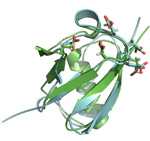A Very High-resolution Crystal Structure of a SUMO-like Domain in a Yeast Rad60
Protein
summary written by Raven Hanna
DNA is a relatively stable molecule, but it can be damaged by chemicals generated inside our cells or by radiation originating from outside our cells. Significant amounts of DNA damage can lead to rapid-aging, cancer, and other diseases, so the cell has a fleet of enzymes that specialize in combating this daily wear-and-tear. One important group of DNA repair enzymes is the Rad60 family of proteins that is highly conserved from yeast to humans. Sequence analysis determined that Rad60 proteins contain two functional domains that are similar to the small ubiquitin modifier (SUMO) domain. The SUMO domain is used by the cell as a molecular tag that is covalently attached to target proteins, to alter their functions and/or cellular localization. The presence of SUMO-like domains suggests that Rad60 proteins can interact with proteins involved the SUMO pathway.
To determine the similarities between Rad60 and SUMO, a research team led by structural biologist John Tainer and geneticist Nick Boddy from The Scripps Research Institute used SSRL Beam Line 11-1 to solve a very high-resolution (0.97 Å) crystal structure of one of the SUMO-like domains of Rad60 from fission yeast. When comparing to a previously known structure of SUMO, the researchers found that the backbones of the two domains were well conserved, but most of the surface features were not. Since the enzyme would interact with other proteins through surface interactions, this suggests that Rad60 does not interact with the same set of proteins, nor undergoes covalent attachment to target proteins. However, one exception was a conserved surface feature known to be important for interactions with a specific factor (Ubc9) in the SUMO pathway, which functions to promote SUMOylation of target proteins. The researchers followed up on this observation with yeast genetics experiments performed performed in Nick Boddy's laboratory. They found that mutating this Ubc9 binding feature and hence, inhibiting Rad60's modulation of Ubc9, made cells more susceptible to DNA damage, which confirms that it is critical to Rad60 function.
This study is the first to explore the structure of SUMO-like proteins in detail. Defining how the SUMO pathway is used in DNA repair will aid our understanding of many diseases, including cancer, Alzheimer's, Parkinson's, and Huntington's. This research was published in the May 1, 2009, issue of Nature Structural and Molecular Biology.
To learn more about this research see the full Scientific Highlight
Prudden, J., Perry, J.J.P., Arvai, A.S., Tainer J.A., Boddy M.N. (2009). Molecular mimicry of SUMO promotes DNA repair. Nature Struct. Mol. Biol. 16(5):509-16.


